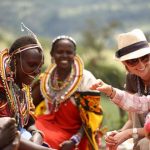
This is also a very spectacular lobo River valley that offers the best wildlife viewing opportunities in northern Serengeti National Park. The wildlife viewing here is at its best most especially during the dry season from mid-July to late November and also from mid-September to late November when the concentration of animals is at its best. The stewart white was also one of the first main explorers to the discovering of the Lobo River Valley is also one of the few areas in East Africa where you can get a chance of seeing all the three species of the big cats. These include; the lions, leopards, and the cheetahs on a single game drive.
There is also the resident lion pride that is commonly known as the Lobo Pride and it’s the second largest pride in the Serengeti and it has 26 individuals. This extended family of the lions is also commonly seen snoozing on the smooth granite kopjes during the heat of the day, prone out in proper lion style. These lions also live on the variety of resident prey animals that also reside in this area throughout the year including the buffalos and the gazelle. In the dry season when the great migration passes through, the hungry pride also stalks the migratory zebras and the wildebeests allowing the resident herbivores some relief from predation.
The leopard are also seen here in the shadowy branches of the yellow barked acacia trees that are in line with the rivers and springs in Lobo Valley. One of the best spots of seeing the leopards in this valley is also near the Lobo springs. The cheetahs are also thinly distributed in the woodlands of the Northern extension and are also seen grazing the tawny grasslands of the Lobo Valley during the dry season due to the presence of the Thomson’s gazelle, which is also its primary prey.
The Lobo Valley is also a good place of the great beauty and the solitude, a scenic delightful in the remote savannah of the Northern Serengeti. In the dry season, when the animals are dramatic, the lobo valley is one of the wonders of the Serengeti. The land scape here is a mosaic of the colourful patterns and the valley is filled with the woodlands, the open plains, the range of hills and the granite kopjes.
This area is also composed of the world’s most ancient rock formations that is estimated 2-3 million years old. There are also sources of the permanent water that also sustains life into the valley throughout the year. These also include; Bololgedi river, Gaboti river, and the Lobo Springs. The other dominant feature in this valley id the Lobo Hill that flanks the eastern side of the valley. There are also old buffalos and many more.
The other resident animals that are found in the Lobo Valley also include; impalas, elephants, baboons, topis, hartebeest, warthogs, giraffes, vervet monkey, dikdik and rock hyrax. There are only two nearby lodges (Migration Camp and Lobo Lodge) so the valley never feels very crowded, which allows for relatively undisturbed game viewing and golden solitude. However, a strong 4×4 car is highly recommended to access and explore Lobo Valley due to the nature of the roads / tracks. You can rent a 4×4 car in Arusha at a very good quote like for Rav4 from US$60 per day and Land cruisers from US$90 per day. There are also extended versions of land cruisers for 7 persons at US$150 per day. However, its more rewarding to explore Lobo valley with a local guide, or park ranger.



